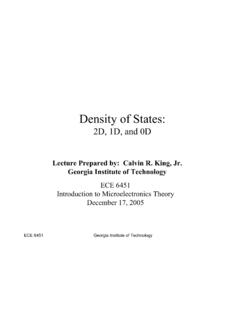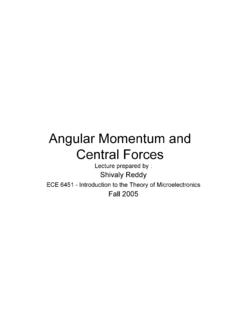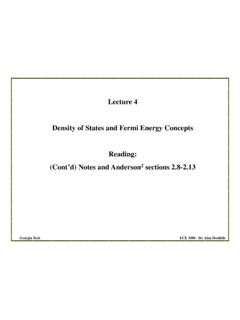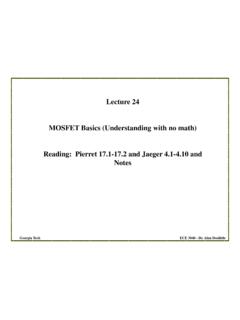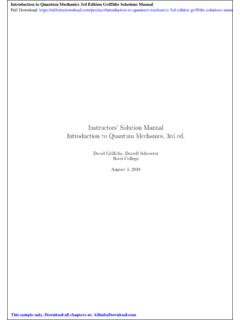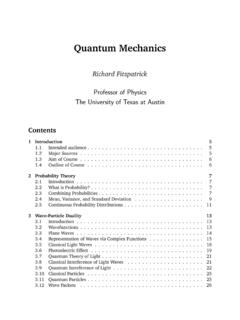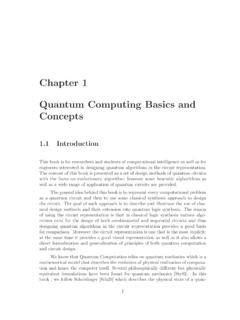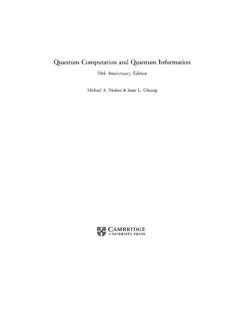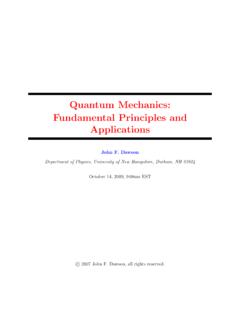Transcription of Lecture 1 Introduction to Semiconductors and …
1 ECE 6451 - Dr. Alan DoolittleGeorgia TechLecture 1 introduction to Semiconductors and Semiconductor DevicesA Background Equalization LectureReading: NotesECE 6451 - Dr. Alan DoolittleGeorgia TechSources of InformationReading: Notes are taken from a combined source of: Brennan The Physics of Semiconductor Devices Solymar and Walsh Electrical Properties of Materials Neudeck and Pierret Advanced Semiconductor Fundamentals Dimitrijev Understanding Semiconductor Devices Mayer and Lau Electronic Materials Science Colclaser and Diehl-Nagle Materials and Devices for electrical engineers and physicists Tipler Physics for scientists and engineers V4. Schubert quantum mechanics Applied to Semiconductor DevicesECE 6451 - Dr.
2 Alan DoolittleGeorgia TechQuantum mechanics allows us to Understand and Design Complex Semiconductors and Devices The goal of this course is to teach the fundamentals of quantum mechanics , a modern approach to physics on the nano scale. Understanding of this important concept leads to the ability to: Understand and design custom semiconductor materials with optical and electrical properties tailored to specific needs Understand and design electrical and optical devices including advanced diodes, LEDs, LASER diodes, transistors (BJT and FET) , and advanced device concepts such as microwave compound Semiconductors and state of the art devices. Even silicon has entered the quantum mechanical domain!
3 Nakamura, S. et al., High-power InGaN single- quantum -well-structure blue and violetlight-emitting diodes, Appl. Phys. Lett67, 1868 (1995).ECE 6451 - Dr. Alan DoolittleGeorgia TechDevices Requiring quantum MechanicsHeterojunction diodes, ballistic diodes, Schottky barrier diodes, Metal-Semiconductor Contacts, LEDs, Lasers, some Solar Cells, Photodetectors, some BJTs, HBT, some MOSFETs, MESFET, JFET, Polarization Based Devices (III-Nitrides HEMTs and Ferroelectric transistors), Microwave transistors, power transistors, some organic 6451 - Dr. Alan DoolittleGeorgia TechModern amplifiers consist of extremely small devices Small means quantum BehaviorTransistors in the above image are only a few microns ( m or 1e-6 meters) on a devices have lateral dimensions that are only fractions of a micron (~ m) and vertical dimensions that may be only a few atoms 6451 - Dr.
4 Alan DoolittleGeorgia TechIntel Develops World's Smallest, Fastest CMOS TransistorSANTA CLARA, Calif., Dec. 11, 2000 - Intel Corporation researchers have achieved a significant breakthrough by building the world's smallest and fastest CMOS transistor. This breakthrough will allow Intel within the next five to 10 years to build microprocessors containing more than 400 million transistors, running at 10 gigahertz (10 billion cycles per second) and operating at less than one volt. The transistors feature structures just 30 nanometers in size and three atomic layers thick.(Note: A nanometer is one-billionth of a meter). Smaller transistors are faster, and fast transistors are the key building block for fast microprocessors, the brains of computers and countless other smart devices.
5 These new transistors, which act like switches controlling the flow of electrons inside a microchip, could complete 400 million calculations in the blink an eye or finish two million calculations in the time it takes a speeding bullet to travel one inch. Scientists expect such powerful microprocessors to allow applications popular in science-fiction stories -- such as instantaneous, real-time voice translation -- to become an everyday reality. Researchers from Intel Labs are disclosing the details of this advance today in San Francisco at the International Electron Devices Meeting, the premier technical conference for semiconductor engineers and scientists. "This breakthrough will allow Intel to continue increasing the performance and reducing the cost of microprocessors well into the future," said Dr.
6 Sunlin Chou, vice president and general manager of Intel's Technology and Manufacturing Group. "As our researchers venture into uncharted areas beyond the previously expected limits of silicon scaling, they find Moore's Law still intact." Intel researchers were able to build these ultra-small transistors by aggressively reducing all of their dimensions. The gate oxides used to build these transistors are just three atomic layers thick. More than 100,000 of these gates would need to be stacked to achieve the thickness of a sheet of paper. Also significant is that these experimental transistors, while featuring capabilities that are generations beyond the most advanced technologies used in manufacturing today, were built using the same physical structure as in today's computer chips.
7 "Many experts thought it would be impossible to build CMOS transistors this small because of electrical leakage problems," notedDr. Gerald Marcyk, director of Intel's Components Research Lab, Technology and Manufacturing Group. "Our research proves that these smaller transistors behave in the same way as today's devices and shows there are no fundamental barriers to producing these devices in high volume in the future. The most important thing about these 30 nanometer transistors is that they are simultaneously small and fast, and work at low voltage. Typically you can achieve two of the three, but delivering on all facets is a significant accomplishment." It's discoveries like these that make me excited about the future," added Chou.
8 "It's one thing to achieve a great technologicalbreakthrough. It's another to have one that is practical and will change everyone's lives. With Intel's 30 nanometer transistor, we have both." For more information on Intel Silicon Technology Research, please reference Intel's new Silicon Showcase at Intel, the world's largest chip maker, is also a leading manufacturer of computer, networking and communications products. Additional information about Intel is available at Source: Intel Web Last Words: I only want to design computers. I do not need to know about atoms and electrons . --- A Doomed Computer EngineerECE 6451 - Dr. Alan DoolittleGeorgia Tech Conductivity, , is the ease with which a given material conducts electricity.
9 Ohms Law: V=IR or J= E where J is current density and E is electric field. Metals: High conductivity Insulators: Low Conductivity Semiconductors : Conductivity can be varied by several orders of magnitude. It is the ability to control conductivity that make Semiconductors useful as current/voltage control elements . Current/Voltage control is the key to switches (digital logic including microprocessors ), amplifiers, LEDs, LASERs, photodetectors, is a Semiconductor? - Control of Conductivity is the Key to Modern Electronic DevicesECE 6451 - Dr. Alan DoolittleGeorgia Tech For metals, the electrons can jump from the valence orbits (outermost core energy levels of the atom) to any position within the crystal (free to move throughout the crystal) with no extra energy needed to be supplied For insulators, it is VERY DIFFICULT for the electrons to jump from the valence orbits and requires a huge amount of energy to free the electron from the atomic core.
10 For Semiconductors , the electrons can jump from the valence orbits but does require a small amount of energy to free the electron from the atomic is a Semiconductor Energy Bandgap?ECE 6451 - Dr. Alan DoolittleGeorgia Tech Semiconductor materials are a sub-class of materials distinguished by the existence of a range of disallowed energies between the energies of the valence electrons (outermost core electrons) and the energies of electrons free to move throughout the material. The energy difference (energy gap or bandgap) between the states in which the electron is bound to the atom and when it is free to conduct throughout the crystal is related to the bonding strength of the material, it s density, the degree of ionicity of the bond, and the chemistry related to the valence of bonding.
